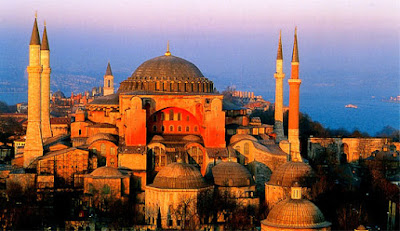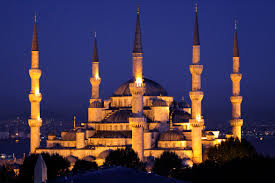The exotic and exciting city of Istanbul is one of the most-visited tourist destinations in the world; the appeal of the Bosphorus Strait, spice markets, and the harem of the sultans is intoxicating. Its history as a former Christian imperial capital (Constantinople) and an important city in the modern Islamic world gives Istanbul a unique cosmopolitan flavor, welcoming to all. Visitors of any background can step inside the city's beautiful mosques to experience the customs and traditions of Turkish Muslims--and learn that they aren't so foreign as outsiders might expect.
Hagia Sophia
For Christians discovering the Muslim world for the first time, there is no better place to start than a building that has been both a Christian church and a mosque. In the heart of the historic Sultanahmet district, this sixth-century domed wonder was the center of Istanbul's religious influence for nearly a thousand years--first as an Eastern Orthodox cathedral, then as a mosque after the Ottomans moved in.
Today, it's a tasteful museum, honoring both traditions and both histories. Note the alterations made during the church's Christian-Muslim transformation: the central apse, originally built to face Jerusalem, has been modified to face a few degrees to the south, to Mecca. The faces of angels and important characters in Christian circles were covered by Islamic calligraphy--depiction of human images is forbidden in mosques. Thankfully, some of the original Christian mosaics and frescoes were only covered with plaster, and have been restored to create the well-balanced presentation seen in Hagia Sophia today.
Blue Mosque
Just across Sultanahmet Square from Hagia Sophia is the much newer--but still pretty venerable, built in 1616--Sultan Ahmet Mosque, commonly called the "Blue Mosque" in English thanks to its highly decorative blue interior. Unlike Hagia Sophia, this is a working, breathing place of worship; neighborhood residents use the mosque for daily prayers, washing themselves in the ritual pre-prayer cleansing with the taps in the courtyard and spending a few minutes in silent meditation inside.
Visitors enter through a separate entrance--no shoes, please--and are requested not to disturb those praying in rows on the floor. No pews in the mosque, just a grand space, decorated with almost impossibly intricate tile mosaics and gold-leaf calligraphy. Rather than sit in rows of hard wooden benches, the faithful kneel in lines marked on the carpet.
Looking around, Christians--practicing and "cultural Christians" alike--will notice echoes of their own traditions: a ritual with water, candles, decorated walls and windows, a central pulpit (called a mihrab) from which a cleric leads a weekly service, an audible signal from a tall tower that services are about to begin (bells for Christian churches, a vocal chant for the mosque). Even modesty rules (no bare shoulders or legs for men or women; women must also wear a head covering) shouldn't seem too unfamiliar--many western religious denominations require strict dress codes.
Mosque of Suleyman the Magnificent
Larger than the Blue Mosque, and high up on a hill overlooking Istanbul's Golden Horn, the Mosque of Suleyman the Magnificent gets significantly less tourist foot traffic than its more famous friends down in Sultanahmet, but it's no less worthy of a visit, and just as welcoming to non-Muslims.
The interior follows many of the same conventions of the Blue Mosque--intensely decorated, high-domed, hauntingly beautiful, and still in use by local worshippers. Before stepping inside, however, visitors are encouraged to explore the cemetery in the courtyard. Just like the traditions of other Abrahamic faiths, Muslims are buried in consecrated ground in view of their places of worship. Walk through the headstones and admire the detailed carvings and finish with a visit to the opulent mausoleums of Suleyman--the Ottoman sultan who funded the construction of this mosque--and his family.
Istanbul has more than its share of touristy excitement and exotic appeal, but Western visitors should consider taking some time to visit these mosques to experience the local traditions firsthand. After visiting these three beautiful, sacred places, you'll have a better understanding of the mainstream Islamic world and its practices, which you might be surprised to see aren't so different after all.




0 comments:
Post a Comment